As winter 2026 rolls across the motorcycle owners are facing more than cold rides — they’re navigating smarter ways to protect their machines. Gone are the days when a quick oil change and a tarp cover did the job. Today’s riders are turning to AI-assisted maintenance reminders, predictive battery analytics, and geo-based weather alerts to keep their bikes in top form through freezing conditions. From smart garage sensors that monitor humidity to eco-formulated lubricants designed for sub-zero performance, winter motorcycle care has entered a new digital era. Whether you ride daily or store your bike till spring, mastering winter maintenance isn’t just about performance — it’s about safety, savings, and sustainability.
Let’s dive into the latest tech-powered methods and timeless tips every rider should know before the first frost hits.
"You are on your own. You are not protected by two tons of steel, rubber, foam padding and safety glass. Neither are you steering two tons of guided missile toward other cars, people and property. If you are prepared to accept the responsibility of your own actions, then motorcycling can be both safe and thrilling. Riding is an art as well as a craft and no amount of explanation can take the place of experience."
Quick Links
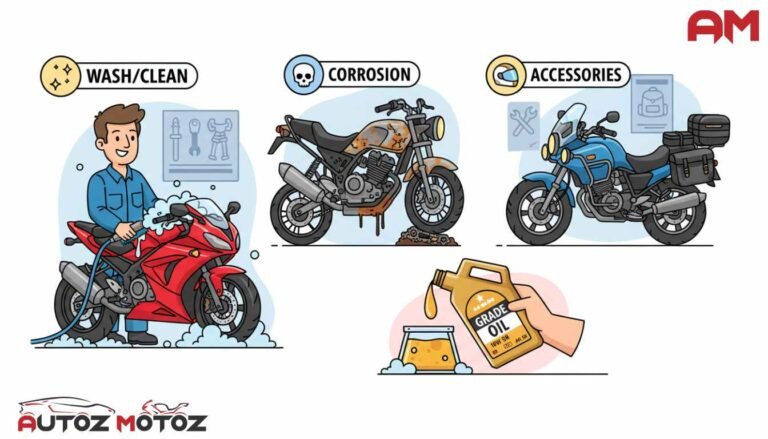
Preparation | Warm-Up
🧼 Wash and Clean Before Winter Storage
Before the chill sets in, give your motorcycle a thorough wash to remove dirt, grime, and salt residues that can accelerate corrosion during winter. Use a pH-balanced cleaner and microfiber mitts to protect the paint. Once washed, dry completely — moisture left in crevices can cause rust. Apply a protective wax coating or ceramic spray to seal surfaces. For chrome parts, use an anti-corrosion polish. Cleaning isn’t just aesthetic; it prevents oxidation and damage over months of inactivity. Riders in northern states like Michigan or Vermont should especially clean salt build-up from previous rides to preserve finishes.
Preventing Corrosion and Rust Formation
Corrosion silently eats away at your motorcycle’s frame and metal parts during damp winter storage. Apply a corrosion inhibitor spray to exposed bolts, undercarriage, and chrome areas. A light coat of WD-40 or ACF-50 provides moisture resistance. Focus on hidden areas like the swingarm and under the seat. Keep your bike covered with a breathable waterproof cover to avoid condensation buildup. For riders near coastal or humid regions, use a dehumidifier or silica gel packs in the garage. Preventing rust before it starts saves hundreds in restoration costs and extends your bike’s lifespan through harsh winters.
Check Accessories and Electrical Add-ons
Winter vibrations and moisture can wreak havoc on accessories and electrical connections. Inspect USB ports, GPS mounts, heated grips, and auxiliary lights for proper insulation. Use dielectric grease to protect connectors and prevent short circuits. Ensure your heated gear wiring is intact and routed away from moving parts. Check mounts and fasteners for tightness; cold weather contraction can loosen bolts. Store removable accessories indoors when not in use. For riders using smart helmets or Bluetooth systems, keep firmware updated and batteries charged monthly to maintain connectivity performance through cold spells.
Use Correct Winter-Grade Engine Oil
Cold temperatures thicken oil, reducing lubrication efficiency. Always switch to a low-viscosity winter-grade engine oil (e.g., 5W-40 or 10W-40) recommended by your manufacturer. Synthetic oils perform better in sub-zero conditions, improving cold starts and reducing wear. Change the oil and filter before winter to remove contaminants that may cause corrosion. Warm the engine after oil changes to circulate clean oil throughout. Riders in colder regions like Minnesota or Colorado should consider adding a fuel stabilizer as well to prevent condensation and ensure smooth ignition after long storage periods.
“Motorcycle maintenance gets frustrating. Angering. Infuriating. That's what makes it interesting.”
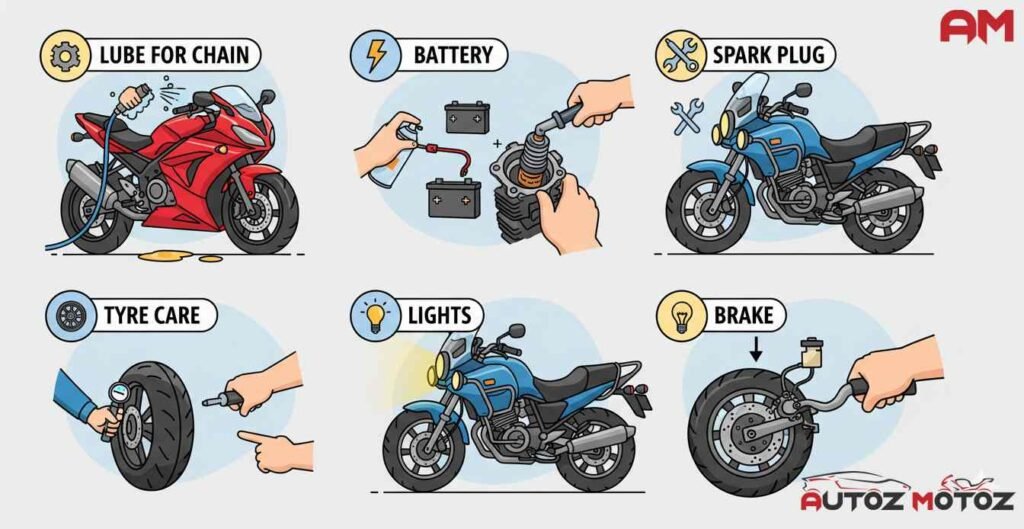
Lubricate the Chain for Winter Durability
A dry or neglected chain suffers most in freezing conditions. Clean the chain thoroughly with a dedicated degreaser, then apply a winter-grade chain lube designed to resist moisture and slush. Rotate the wheel manually to coat every link evenly. For longer storage, over-lubricate slightly to protect against rust. Inspect the sprocket for wear or alignment issues. Avoid using regular motor oil — it collects dust and salt. Riders who frequently commute during winter should lube the chain every 300–400 miles or after exposure to snow, salt, or heavy rain.
🔋 Battery Health and Winter Charging
Cold drains motorcycle batteries faster than any other season. Disconnect and store your battery indoors if you won’t ride for weeks. Use a smart trickle charger or battery tender to maintain optimal voltage. For riders still using lead-acid batteries, check the electrolyte level and terminals for corrosion. Lithium-ion batteries are better suited for modern motorcycles due to superior cold-cranking power. Keep the battery in a dry, moderate-temperature area — extreme cold can permanently damage its capacity. Before restarting in spring, test voltage levels to ensure it delivers the expected charge.
🔌 Inspect Spark Plugs for Reliable Ignition
Spark plugs endure stress during cold starts. Remove and inspect each plug for carbon deposits or corrosion. Replace if the electrode appears worn or the gap is inconsistent with your bike’s specification. Use anti-seize compound on threads to prevent binding in the cold. Check plug wires and caps for cracks — a minor crack can lead to misfires when moisture seeps in. Upgrading to iridium plugs can improve winter ignition reliability. A healthy spark plug ensures smooth starts, consistent combustion, and optimal fuel economy even in near-freezing conditions.
Tire Care and Pressure Maintenance
Cold air causes tire pressure to drop significantly, compromising traction. Check and adjust tire pressure weekly using an accurate gauge. Inspect for cracks, hardening, or flat spots caused by cold concrete contact. Use silica-infused winter tires or all-season compounds for better grip below 45°F (7°C). Avoid riding with underinflated tires — it reduces stability and increases wear. Store your motorcycle on paddock stands or move it occasionally to prevent flat spots. Always check tire tread depth; in winter, deeper tread is vital for channeling water and maintaining grip on icy roads.
💡 Lighting and Visibility Enhancement
Winter’s shorter days demand maximum visibility. Clean headlight lenses and upgrade to LED or adaptive headlights for brighter illumination. Check all bulbs, including indicators and brake lights, for operation. Apply dielectric grease to sockets to prevent moisture corrosion. Consider installing auxiliary fog lights for improved visibility during snow or heavy fog. Reflective tape on fairings and helmets increases night-time presence. For electric motorcycles, ensure light connections are shielded from water ingress. Better lighting not only enhances your visibility to others but also extends reaction time in poor winter conditions.
🛑 Brake System Check and Fluid Replacement
Cold weather thickens brake fluid, reducing performance. Inspect fluid levels and color — dark or murky fluid signals contamination. Replace with fresh DOT-approved brake fluid compatible with your bike’s system. Check calipers for corrosion, pads for adequate thickness, and rotors for warping. Lubricate moving parts with high-temperature grease to prevent sticking. Test braking power in a safe area before your first winter ride. Anti-lock Braking Systems (ABS) should be recalibrated if error lights appear. Reliable brakes are non-negotiable in winter; they ensure control on slippery roads and during emergency stops.

Winter Motorcycle Challenges in 2026
- Weather Mismatch: Sudden algorithmic weather alerts often misjudge microclimates, leaving riders unprepared for icy surprises.
- EV Battery Degradation: Cold snaps reduce range up to 30%, especially in electric motorcycles with older lithium packs.
Smart Sensor Glitches: Ice buildup confuses adaptive traction sensors, triggering false safety alerts.
Tire Grip Decline: Even advanced nano-silica winter compounds lose elasticity below 20°F.
Foggy HUD Displays: Smart visors fog up despite built-in defog systems, disrupting augmented navigation.
Frozen Brake Fluid Lines: Inconsistent fluid density impacts ABS response in hybrid braking systems.
Road Salt Corrosion: Smart metals resist it better, but electronic contact points remain highly vulnerable.
Reduced AI Calibration: Cold weather affects onboard AI-learning data accuracy for torque response.
Rider Fatigue Sensors: Over-layered winter gear interferes with biometric monitors.
Insurance Risk Models: Predictive AI insurers now flag winter riding as “high-risk behavior” with premium surcharges.
In 2026, winter motorcycling will blend the thrill of the open road with the intelligence of new-age technology. Heated gear, adaptive rider-assist systems, and AI-powered diagnostics are transforming cold-weather riding — yet traditional risks like traction loss, battery drain, and hypothermia remain real challenges for every rider.
Technology and Gear Challenges
Cold weather still tests every mechanical and human limit. Below 50°F (10°C), tires stiffen, oil thickens, and performance dips sharply. Modern engines with electronic fuel injection (EFI) and ECU calibration mitigate some effects, but older or neglected bikes remain vulnerable to wear and sluggish starts.
Even with advanced heated apparel, riders face fatigue, reduced reaction times, and potential hypothermia during long commutes. Battery performance is another concern — traditional lead-acid units can lose up to 50% efficiency in freezing temperatures, making battery tenders or lithium-ion upgrades essential.
Safety and Road Condition Risks
Winter roads demand heightened awareness. Reduced traction, black ice, and foggy visibility can turn short rides hazardous. While urban roads benefit from mild heat retention, rural and shaded routes near bodies of water often hide treacherous slick spots. Add road salt corrosion and the risk extends beyond the ride to your motorcycle’s longevity.
Evolving Challenges : 2026 Trends
The digital layer of winter riding is expanding. Smart helmets, connected gloves, and integrated sensors must now be recalibrated for temperature accuracy. Yet, innovation comes at a cost — premium safety wear like airbag suits and biometric monitoring gear remains pricey.
Meanwhile, the rise of electric motorcycles introduces new challenges: battery range degradation in sub-zero climates and the need for specialized cold-weather charging and maintenance routines.
Innovations and Smart Solutions
Manufacturers are responding with cornering-sensitive ABS, traction control, and real-time diagnostics. Models such as the 2026 Triumph Bonneville Bobber exemplify how AI and hardware synergy can make cold rides safer.
Riders benefit from biometric feedback gear that monitors vitals, adjusts ride parameters, and helps prevent fatigue-related errors. New textile engineering ensures heated apparel is lighter, more flexible, and energy-efficient, while mobile maintenance apps deliver live alerts on performance, tire pressure, and battery health — redefining what “winter readiness” means in 2026.
“Not everyone understands what a completely rational process this is, this maintenance of a motorcycle. They think it's some kind of "knack" or some kind of "affinity for machines" in operation. They are right, but the knack is almost purely a process of reason, and most of the troubles are caused by what old time radio men called a "short between the earphones," failures to use the head properly. A motorcycle functions entirely in accordance with the laws of reason, and a study of the art of motorcycle maintenance is really a miniature study of the art of rationality itself.”
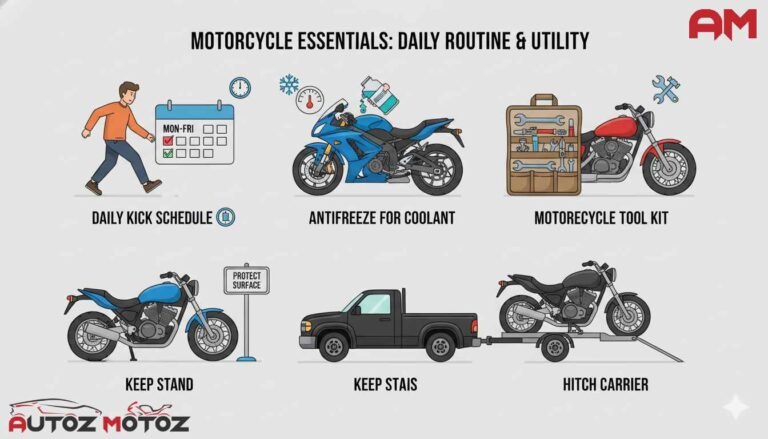
Motorcycle Essentials : Routines & Utility
🕒 Set a Daily Kick-Start Schedule
Even when you’re not riding daily, start your motorcycle every few days to circulate oil and prevent battery discharge. This habit keeps internal parts lubricated, avoids engine stiffness, and ensures smooth ignition when temperatures drop — a simple winter ritual that extends your bike’s overall life.
🧊 Use Antifreeze Coolant for Cold Protection
Winter can freeze the coolant in your engine, causing cracks and overheating once you ride. Always use antifreeze-rated coolant designed for motorcycles. Check its freezing point and fluid level regularly. Avoid tap water mixtures — they dilute protection. A fresh coolant change before winter ensures peace of mind.
🧰 Carry a Compact Motorcycle Tool Kit
A well-packed tool kit is a winter essential. Include wrenches, screwdrivers, tire pressure gauge, spark plug wrench, and a small LED flashlight. Cold weather breakdowns are unpredictable, so being self-sufficient helps you handle small fixes instantly. Store it in a waterproof pouch under your seat or luggage.
🏍️ Keep the Stand Stable
Cold weather often makes ground surfaces unstable — snow, ice, or moisture can make your motorcycle slip off its stand. Use a side-stand puck or pad for stability, especially on soft or icy surfaces. Ensure the parking spot is level and shaded to prevent tip-overs during thaw.
🚚 Use a Motorcycle Hitch Carrier for Transport
When riding conditions become too harsh, a motorcycle hitch carrier is the safest option for transport. It allows easy movement of your bike without road wear or exposure to corrosive salt. Choose a carrier rated for your bike’s weight, and secure it using ratchet straps for stability.
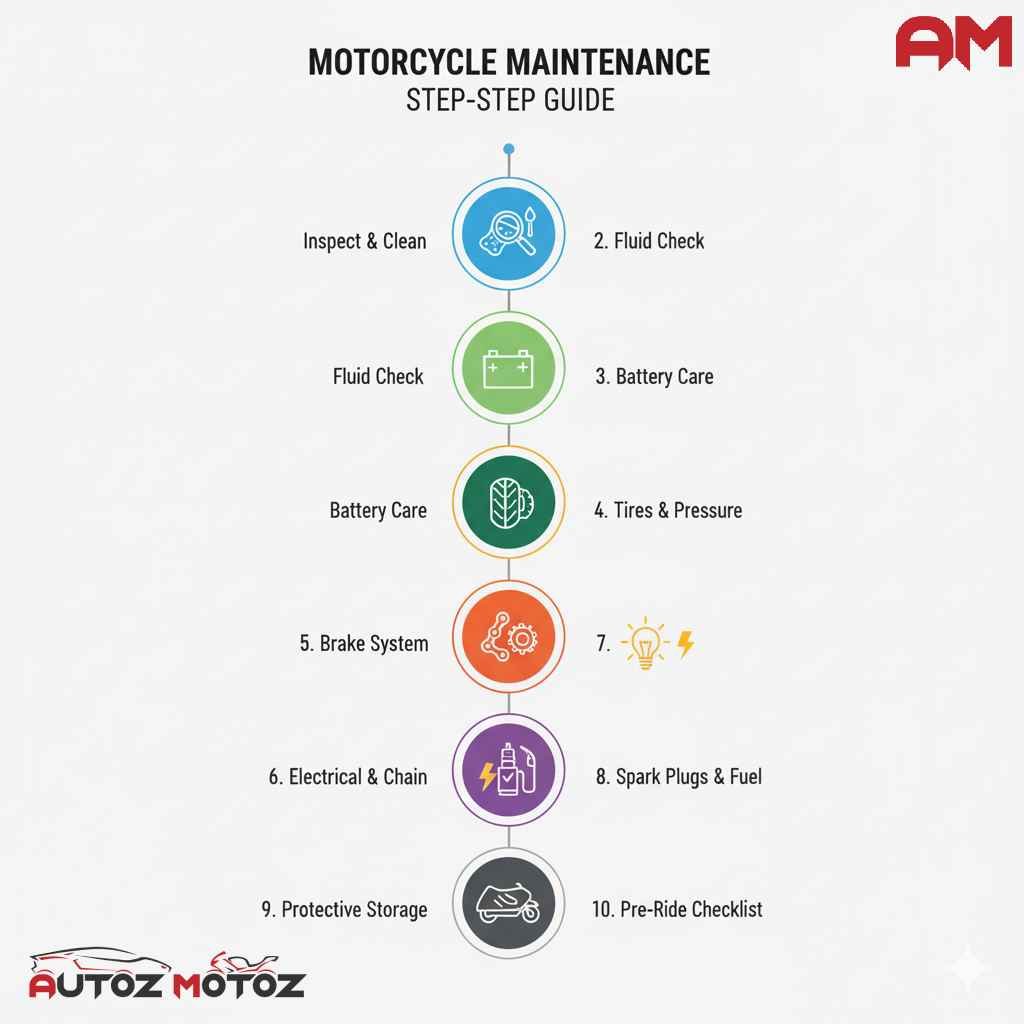
Step by step maintenance checklists
Inspect & Clean — Wash bike; dry thoroughly. Remove salt and apply corrosion inhibitor to frame and chrome.
Fluid Check — Replace engine oil with winter-grade synthetic; top off antifreeze/coolant to spec.
Battery Care — Test voltage, clean terminals, hook to a smart tender if stored; consider lithium upgrade for cold starts.
Tires & Pressure — Inflate to manufacturer cold-pressure; inspect tread and replace if <3mm; use winter/all-season tires when needed.
Brake System — Flush/replace brake fluid if dark; check pads, rotors, and ABS lights; test braking in a safe area.
Drivetrain & Chain — Clean, inspect sprockets, adjust tension, apply winter-grade lube.
Electrical & Lights — Verify headlights, indicators, connectors; apply dielectric grease to sockets.
Spark Plugs & Fuel — Inspect/replace plugs; add fuel stabilizer and run engine to circulate.
Protective Storage — Use breathable cover, stand on paddock or blocks; place silica packs or dehumidifier in garage.
Pre-Ride Checklist — Warm engine, recheck tire pressure, lights, and controls before every winter ride.
"De-winterising is the reverse process – checking everything’s functioning properly before riding your motorcycle again in the spring. This ensures your bike is safe and road-ready."
Bold Checklists for Rider
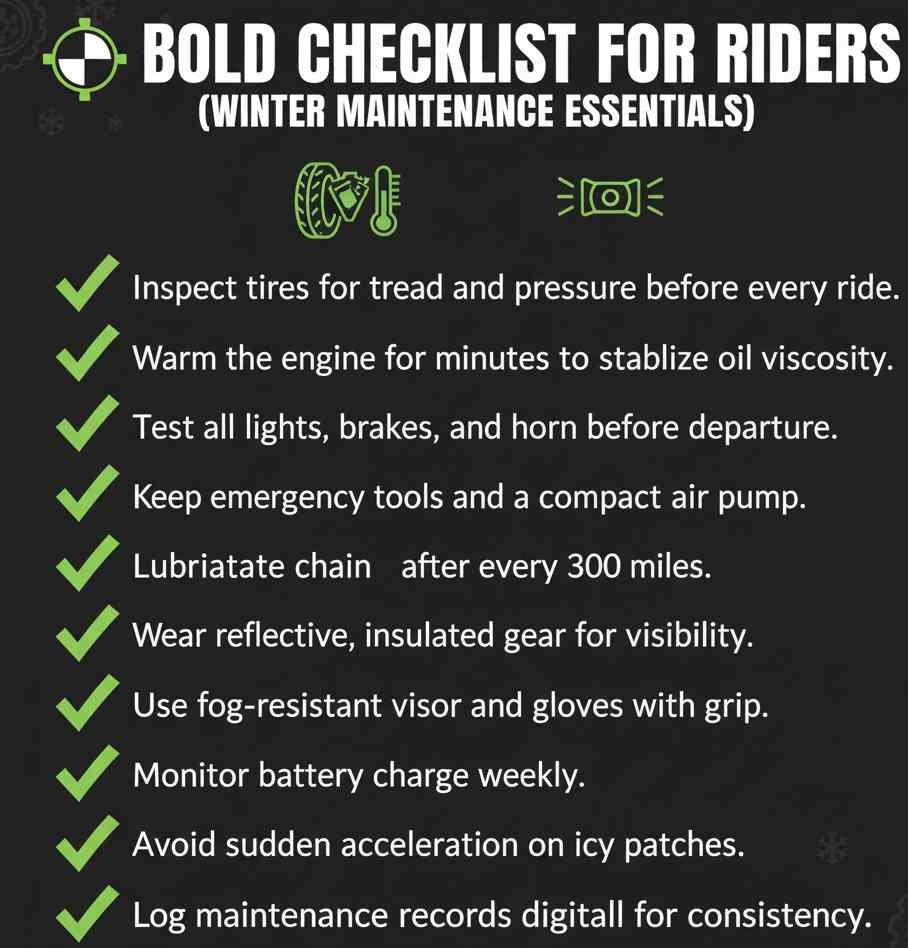
🌍 Sub-Continent Based Suggestions
🇺🇸 North America:
Focus on tire traction and salt protection. Use corrosion-proof sprays after every wash. Riders in colder states should switch to 0W-40 synthetic oil and heated gloves. Keep a portable jump starter in saddlebags for emergencies.
🇪🇺 Europe:
Prioritize wet-weather performance—install ABS sensors and traction aids. Regularly rinse undercarriage salt, especially in Nordic countries. In Central Europe, antifreeze coolant checkups are vital before frost.
🇮🇳 South Asia:
Dust and humidity complicate winter maintenance. Use anti-rust sprays, keep battery terminals covered, and clean air filters weekly. Chain lubrication and brake checks are crucial due to fog and low visibility.
🇯🇵 East Asia:
Cold yet urban conditions require daily startup warmups. Riders should rely on OEM-recommended battery tenders and wear moisture-wicking thermal layers.
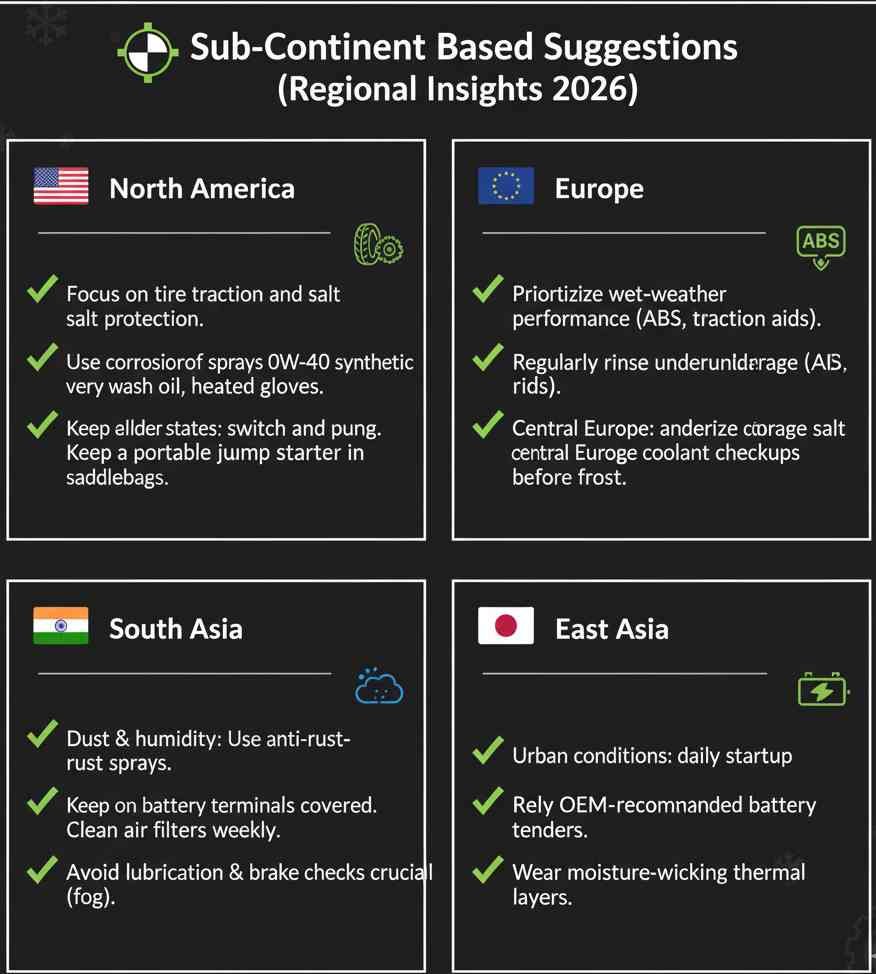
If You Were Injured While Riding — Contact Your Lawyer As First Priority
If an accident occurs, your first step after medical attention should be contacting a motorcycle accident lawyer. Document the scene with photos, record witness details, and preserve damaged gear as evidence. Legal professionals can assess liability, negotiate insurance claims, and ensure rightful compensation for injuries or damages.
❓ Frequently Asked Questions
1️⃣ How should I prepare my motorcycle for winter riding in 2026?
Clean thoroughly, apply anti-corrosion spray, check battery health, use synthetic oil, and warm up your bike before every ride to ensure peak performance.
2️⃣ Does cold weather affect motorcycle batteries?
Yes. In sub-freezing temperatures, lead-acid batteries lose up to 50% efficiency. Use lithium-ion replacements or battery tenders to maintain consistent charge.
3️⃣ What oil is best for motorcycles in cold weather?
Choose fully synthetic oil with low-temperature viscosity (e.g., 0W-40 or 5W-40) to maintain lubrication during cold starts.
4️⃣ Should I store my motorcycle or ride during winter?
If temperatures stay below freezing, store indoors with fuel stabilizer. Otherwise, ride short distances weekly to keep fluids and seals active.
5️⃣ How can I prevent rust and corrosion in winter?
Rinse off salt and grime after each ride. Apply anti-rust spray or ceramic coat to metal parts and chain.
6️⃣ What are the safest tires for winter riding?
Use dual-compound or all-season tires with silica-rich treads. In extreme cold regions, consider studded tires for additional grip.
7️⃣ How does winter affect electric motorcycles?
Cold temperatures can reduce range by up to 25%. Keep batteries warm, charge indoors, and monitor via companion apps.
8️⃣ What riding gear helps prevent hypothermia?
Invest in heated gloves, thermal base layers, moisture-wicking socks, and windproof outer shells. Smart heated jackets with battery control apps are trending in 2026.
9️⃣ How often should I lubricate the chain during winter?
Lubricate every 200–300 miles or after riding through rain or slush to avoid rust buildup and chain stiffness.
🔟 Are there apps that assist with winter motorcycle maintenance?
Yes. Modern rider apps track tire pressure, oil health, and battery charge. AI-based platforms like RideVision or Motobrain provide predictive maintenance alerts.
Conclusion
Winter motorcycle maintenance in 2026 is more than routine care — it’s a synergy of smart tech, preventive upkeep, and safety discipline. With connected apps, heated gear, and proactive planning, riders can conquer winter challenges confidently. Protect your machine, prioritize your safety, and ride every mile smarter this winter season.

Graceful Performance : Motorcycle Riding Pants for Modern Riders
Let’s be real, when people shop for motorcycle pants now, they want more than just tough gear. Sure, staying safe is huge—nobody’s out here looking

Do digital speedometers play any role on the road?
For decades, drivers relied on analog gauges to monitor speed, yet today’s roads demand sharper accuracy and faster response. A modern speedometer isn’t just a

Different Car Type, Body Type Explanations
Overview Today’s car market includes around 400 models of cars with no. of different car types. Making sense of it all is often difficult. What
Tech innovator and business strategist with a foundation in Computer Science and diverse expertise in IT, marketing, and banking. Committed to building disruptive products and customer experiences that shape industries and create global market dominance.








